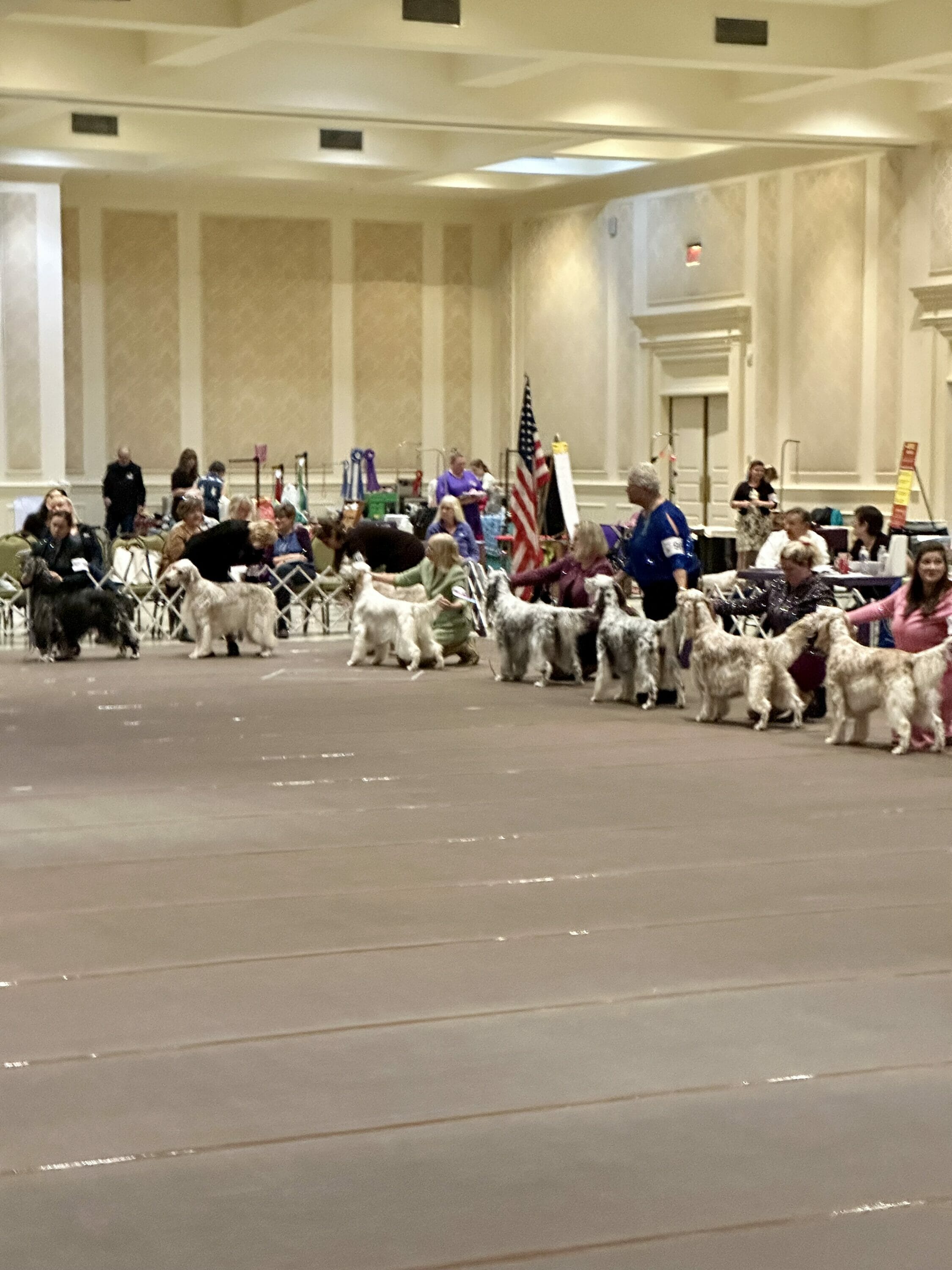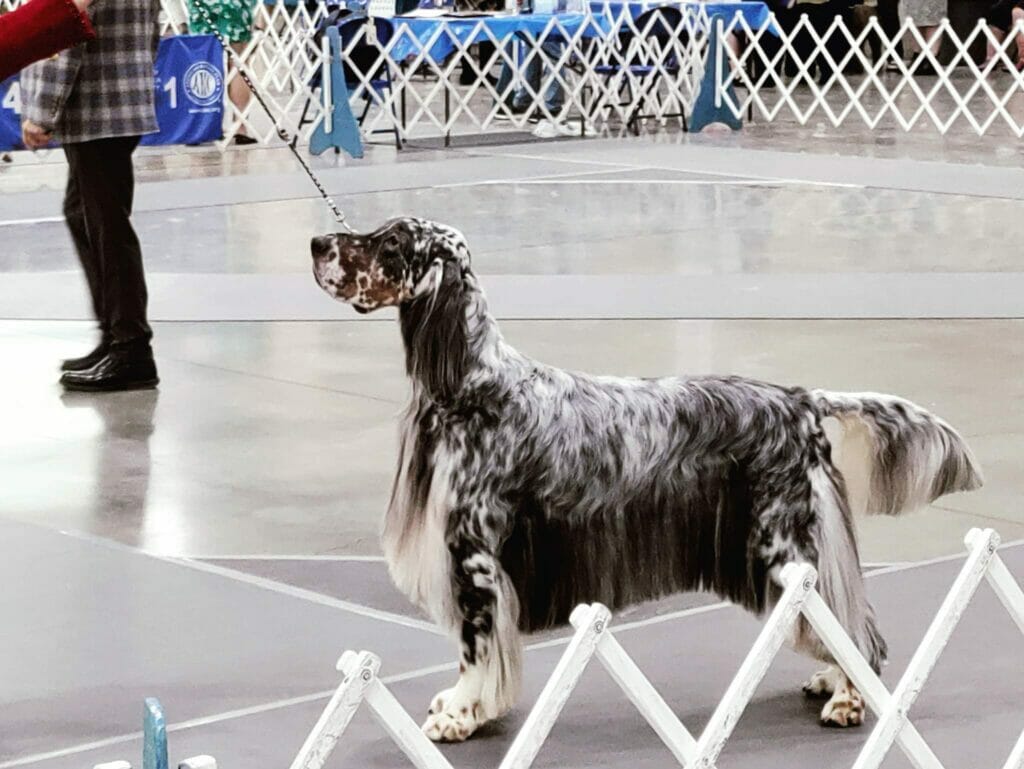
English Setters Breed Standard
Approved November 11, 1986

General Appearance
An elegant, substantial and symmetrical gun dog suggesting the ideal blend of strength, stamina, grace, and style. Flat-coated with feathering of good length. Gaiting freely and smoothly with long forward reach, strong rear drive and firm topline. Males decidedly masculine without coarseness. Females decidedly feminine without over-refinement. Overall appearance, balance, gait, and purpose to be given more emphasis than any component part. Above all, extremes of anything distort type and must be faulted.
Head
Size and proportion in harmony with body. Long and lean with a well defined stop. When viewed from the side, head planes (top of muzzle, top of skull and bottom of lower jaw) are parallel.
Skull
Oval when viewed from above, of medium width, without coarseness, and only slightly wider at the earset than at the brow. Moderately defined occipital protuberance. Length of skull from occiput to stop equal in length of muzzle.
Muzzle
Long and square when viewed from the side, of good depth with flews squared and fairly pendant. Width in harmony with width of skull and equal at nose and stop. Level from eyes to tip of nose.
Nose
Black or dark brown, fully pigmented. Nostrils wide apart and large.
Teeth
Close scissors bite preferred. Even bite acceptable.
Foreface
Skeletal structure under the eyes well chiseled with no suggestion of fullness. Cheeks present a smooth and clean-cut appearance.
Eyes
Dark brown, the darker the better. Bright, and spaced to give a mild and intelligent expression. Nearly round, fairly large, neither deep-set nor protruding. Eyelid rims dark and fully pigmented. Lids fit tightly so that haw is not exposed.
Ears
Set well back and low, even with or below eye level. When relaxed carried close to the head. Of moderate length, slightly rounded at the ends, moderately thin leather, and covered with silky hair.
Neck & Body
Neck
Long and graceful, muscular and lean. Arched at the crest and cleancut where it joins the head at the base of the skull. Larger and more muscular toward the shoulders, with the base of the neck flowing smoothly into the shoulders. Not too throaty.
Topline
In motion or standing appears level or sloping slightly downward without sway or drop from withers to tail forming a graceful outline of medium length.
Forechest
Well developed, point of sternum projecting slightly in front of point of shoulder/upper arm joint.
Chest
Deep, but not so wide or round as to interfere with the action of the forelegs. Brisket deep enough to reach the level of the elbow.
Ribs
Long, springing gradually to the middle of the body, then tapering as they approach the end of the chest cavity.
Back
Straight and strong at its junction with loin. Loin–strong, moderate in length, slightly arched. Tuck up moderate.
Hips
Croup nearly flat. Hip bones wide apart, hips rounded and blending smoothly into hind legs.
Tail
A smooth continuation of the topline. Tapering to a fine point with only sufficient length to reach the hock joint or slightly less. Carried straight and level with the back. Feathering straight and silky, hanging loosely in a fringe.
Forequarters
Shoulder
Shoulder blade well laid back. Upper arm equal in length to and forming a nearly right angle with the shoulder blade. Shoulders fairly close together at the tips. Shoulder blades lie flat and meld smoothly with contours of body.
Forelegs
From front or side, forelegs straight and parallel. Elbows have no tendency to turn in or out when standing or gaiting. Arm flat and muscular. Bone substantial but not coarse and muscles hard and devoid of flabbiness.
Pasterns
Short, strong and nearly round with the slope deviating very slightly forward from the perpendicular.
Feet
Face directly forward. Toes closely set, strong and well arched. Pads well developed and tough. Dewclaws may be removed.
Hindquarters
Wide, muscular thighs and well developed lower thighs. Pelvis equal in length to and forming a nearly right angle with upper thigh. In balance with forequarter assembly. Stifle well bent and strong. Lower thigh only slightly longer than upper thigh. Hock joint well bent and strong. Rear pastern short, strong, nearly round and perpendicular to the ground. Hind legs, when seen from the rear, straight and parallel to each other. Hock joints have no tendency to turn in or out when standing or gaiting.
Coat
Flat without curl or wooliness. Feathering on ears, chest, abdomen, underside of thighs, back of all legs and on the tail of good length but not so excessive as to hide true lines and movement or to affect the dog’s appearance or function as a sporting dog.
Markings & Color
Markings
White ground color with intermingling of darker hairs resulting in belton markings varying in degree from clear distinct flecking to roan shading, but flecked all over preferred. Head and ear patches acceptable, heavy patches of color on the body undesirable.
Color
Orange belton, blue belton (white with black markings), tricolor (blue belton with tan on muzzle, over the eyes and on the legs), lemon belton, liver belton.
Movement & Carriage
An effortless graceful movement demonstrating endurance while covering ground efficiently. Long forward reach and strong rear drive with a lively tail and a proud head carriage. Head may be carried slightly lower when moving to allow for greater reach of forelegs. The back strong, firm, and free of roll. When moving at a trot, as speed increases, the legs tend to converge toward a line representing the center of gravity.
Size
Dogs about 25 inches; bitches about 24 inches.
Temperament
Gentle, affectionate, friendly, without shyness, fear or viciousness.
ESAA Breed Mentor Program
Mentors should be people with good integrity, honesty, and have the welfare of the breed and ESAA above their own personal agenda. They need to work well with people, and have good communication skills.
Minimum Requirements
- 15 years active experience in the breed.
- ESAA member for 12 years and must be in good standing with both ESAA and AKC.
- Attended at least 5 ESAA National Specialties, 2 of them in the past 3 years.
- Bred 5 litters and made a strong effort to breed to the AKC standard and have had at least 5 homebred champions.
- Must have knowledge of the background, history and function of the breed.
- Attended or assisted in the ESAA Judges Education breed study at least 1 time.
- Have experience in judging the breed or in sweepstakes.
- Have a time available to devote to potential judges requesting meetings or other interactions.
Strongly Recommended
Have attended at least 1 field event involving English Setters, AKC Hunt Test or Field Trial.
Additional Guidelines
- To use ESAA materials when mentoring or making a presentation.
- Concentrate on virtues rather than faults.
- Be objective and positive
- Conduct yourself appropriately as a representative of ESAA.
- Must discuss dogs as per the standard, show records should not be discussed and promotion of individual dogs or kennels is not acceptable.
These requirements and guidelines will be updated as necessary with Board of Directors approval.